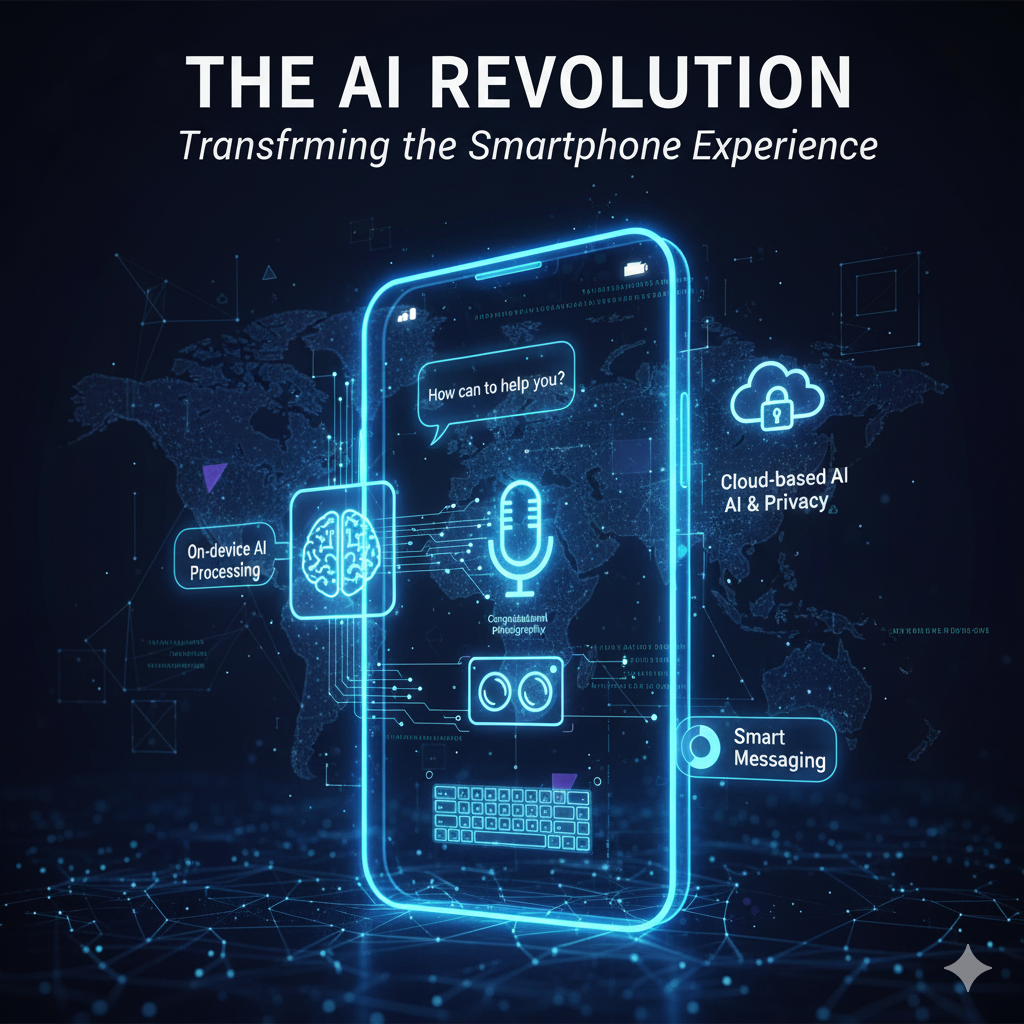AI is fundamentally transforming how we interact with smartphones. It’s moving them from reactive tools—devices that simply wait for your commands to proactive digital companions—that learn, adapt, and anticipate your needs before you even ask. This shift is already visible across key areas like personalization, communication, and photography, and it is poised to deepen dramatically with the integration of generative AI.
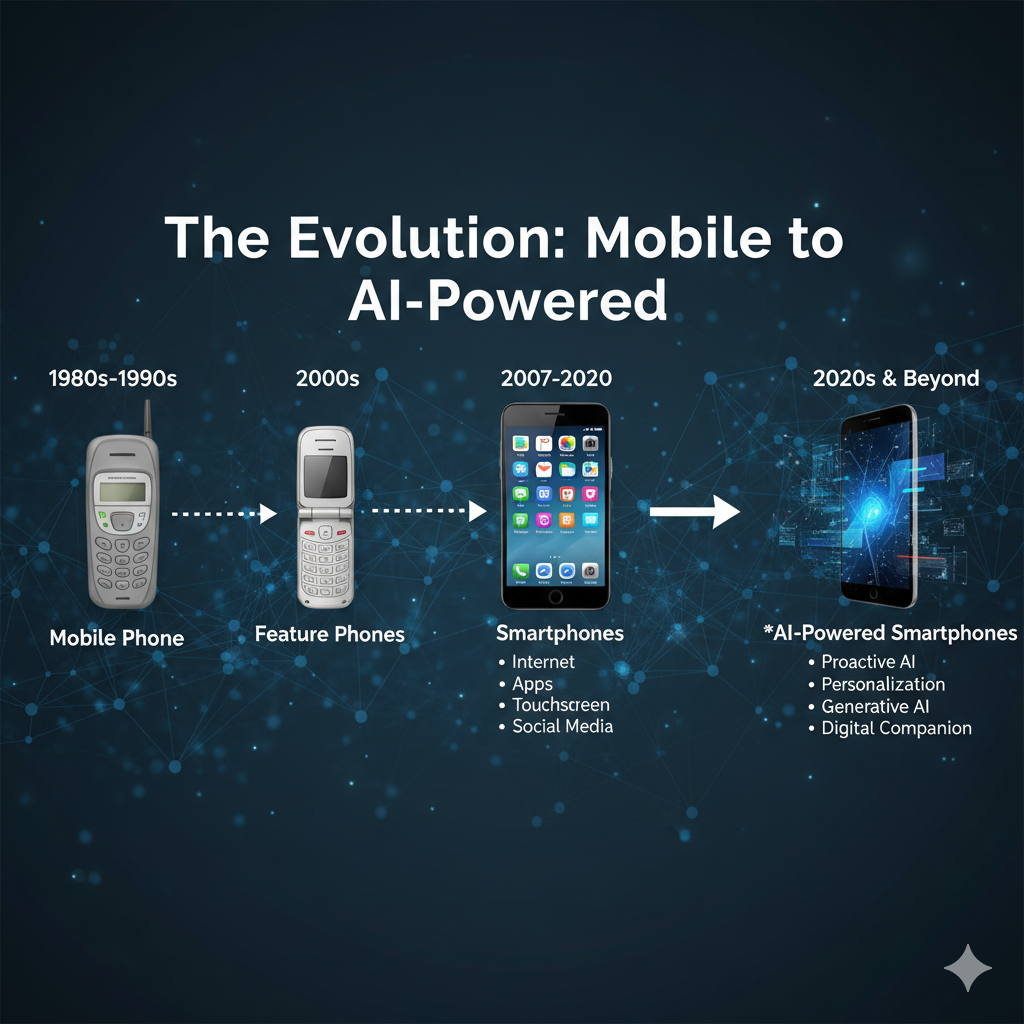
But here’s the catch: while manufacturers race to pack phones with AI features, many users are figuring out whether these innovations actually make their lives easier or just add complexity.
The Current State of AI in Smartphones
AI is a present reality baked into the devices we already use. Every time you unlock your phone with your face, get a smart reply suggestion in your messages, or snap a stunning low-light photo, that’s AI working behind the scenes.
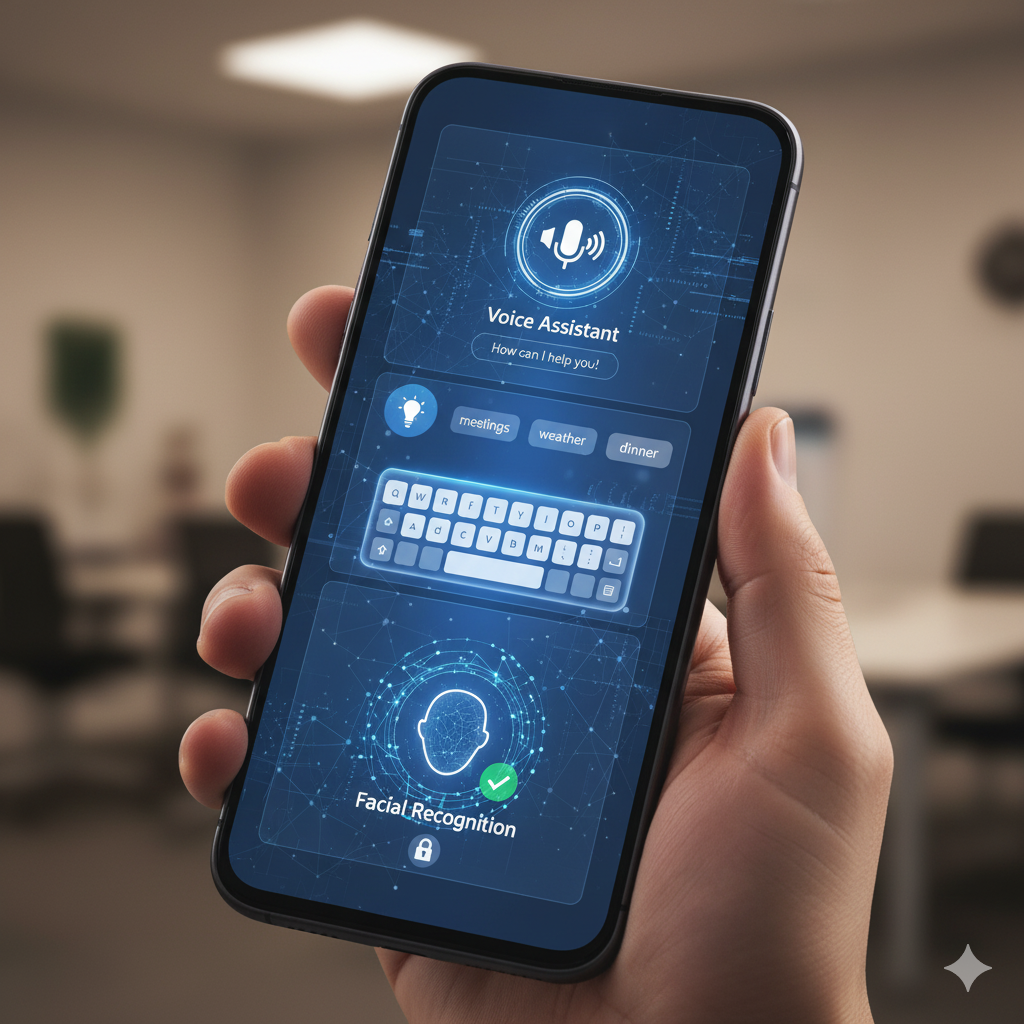
What AI Features Are Already Here?
The most familiar examples include:
- Voice assistants such as Siri, Google Assistant, and Bixby, which process natural language to execute commands.
- Computational photography, where software algorithms, not just lenses, are responsible for stunning images, including Portrait mode and advanced Night mode.
- Predictive text and smart keyboards that learn our vocabulary and anticipate our next word.
- Facial recognition and biometric security that instantly unlock and secure the device.
- Battery optimization and performance management systems that learn usage patterns to extend device life and speed.
How Does AI Actually Work in Smartphones?
This intelligence is powered by a sophisticated technical stack. Thanks to specialized hardware built into modern smartphone chips. Neural Processing Units (NPUs)—also called AI accelerators—work alongside traditional CPUs and GPUs to handle machine learning tasks efficiently. This on-device processing means your phone can perform many AI functions without sending data to the cloud, improving both speed and privacy.
Think of NPUs as specialized brains designed specifically for AI calculations. They can process billions of operations per second while using less power than traditional processors, making real-time AI features possible on a battery-powered device that fits in your pocket.
Core Ways AI Transforms Your Smartphone Experience
Personalization and Predictive Behavior
How does AI personalize smartphone experience? It learns from your daily habits and automatically adjusts to fit your routine. Your phone notices patterns you might not even be aware of.
Modern smartphones use AI to:
- Recommend the right apps at the right time (work tools during business hours, entertainment apps on weekends)
- Suggest navigation routes by analyzing your calendar appointments, real-time traffic, and typical destinations
- Deliver proactive notifications that feel helpful rather than intrusive—like reminding you to leave early when traffic is heavy
- Organize your home screen based on which apps you reach for most frequently
This kind of contextual awareness transforms phones from dumb devices into intelligent assistants that anticipate needs.
Smarter, More Natural Communication
Communication has become seamless with AI-powered features that work in real-time:
Text and messaging improvements:
- Predictive text that completes sentences accurately
- Smart reply suggestions that match your conversational style
- Real-time language translation for conversations across language barriers
AI-enhanced calling:
- Intelligent call screening that blocks spam and transcribes legitimate calls
- Live transcription during phone conversations
- Advanced noise cancellation that isolates your voice from background chaos
Google’s Call Screen feature, for example, can answer unknown calls for you and display a real-time transcript, letting you decide whether to pick up—all while keeping spam callers at bay.
The Photography Revolution
How does AI improve smartphone camera quality? Computational photography uses AI to overcome the physical limitations of tiny smartphone camera sensors, producing images that rival professional equipment. This is one of AI’s most impressive achievements in smartphones.
Here’s what happens when you press the shutter button:
AI algorithms analyze and optimize images by recognizing scenes, objects, and even human faces to adjust camera settings automatically. AI cameras improve image quality by adjusting to different lighting conditions, enhancing colors and details, and reducing noise and blur.
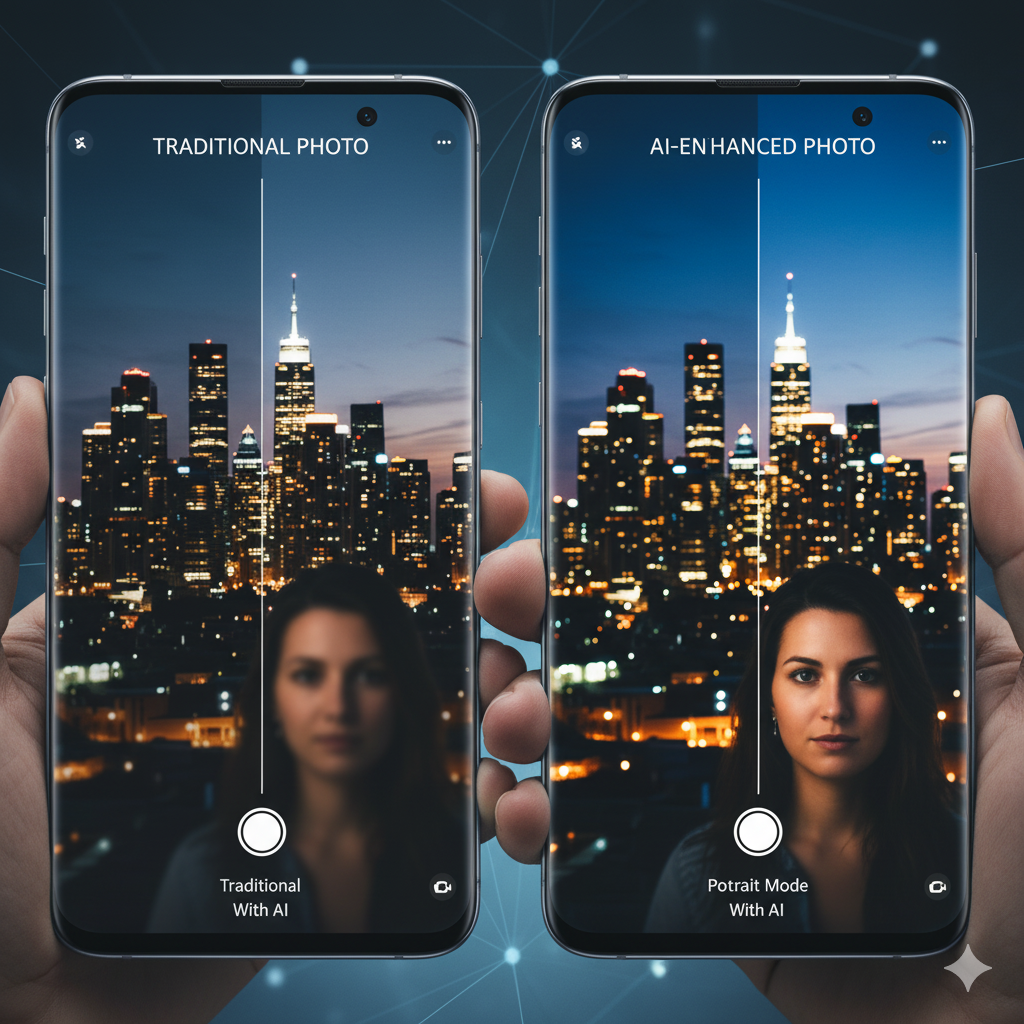
Key AI photography features:
- Intelligent scene recognition that instantly identifies what you’re shooting (sunset, food, pets, documents) and optimizes settings accordingly
- Portrait mode that creates professional-looking depth effects by distinguishing subjects from backgrounds
- Night mode that combines multiple exposures to capture stunning low-light photos
- AI-powered editing that can remove unwanted objects, enhance specific elements, or completely transform image aesthetics
AI noise reduction techniques accurately mitigate ISO noise to provide consistently better results that retain fine details, particularly in low-light environments. The result? Many professional photographers say pictures taken by modern AI camera smartphones are better than those from expensive, pro-grade DSLRs.
The Generative AI Wave (2024–2025)
From Smart Features to Creative Partners
2024 and 2025 marked a turning point: smartphones moved beyond performing preset AI tasks to generating completely new content. Large language models that previously only ran on powerful servers are now working directly on your phone.
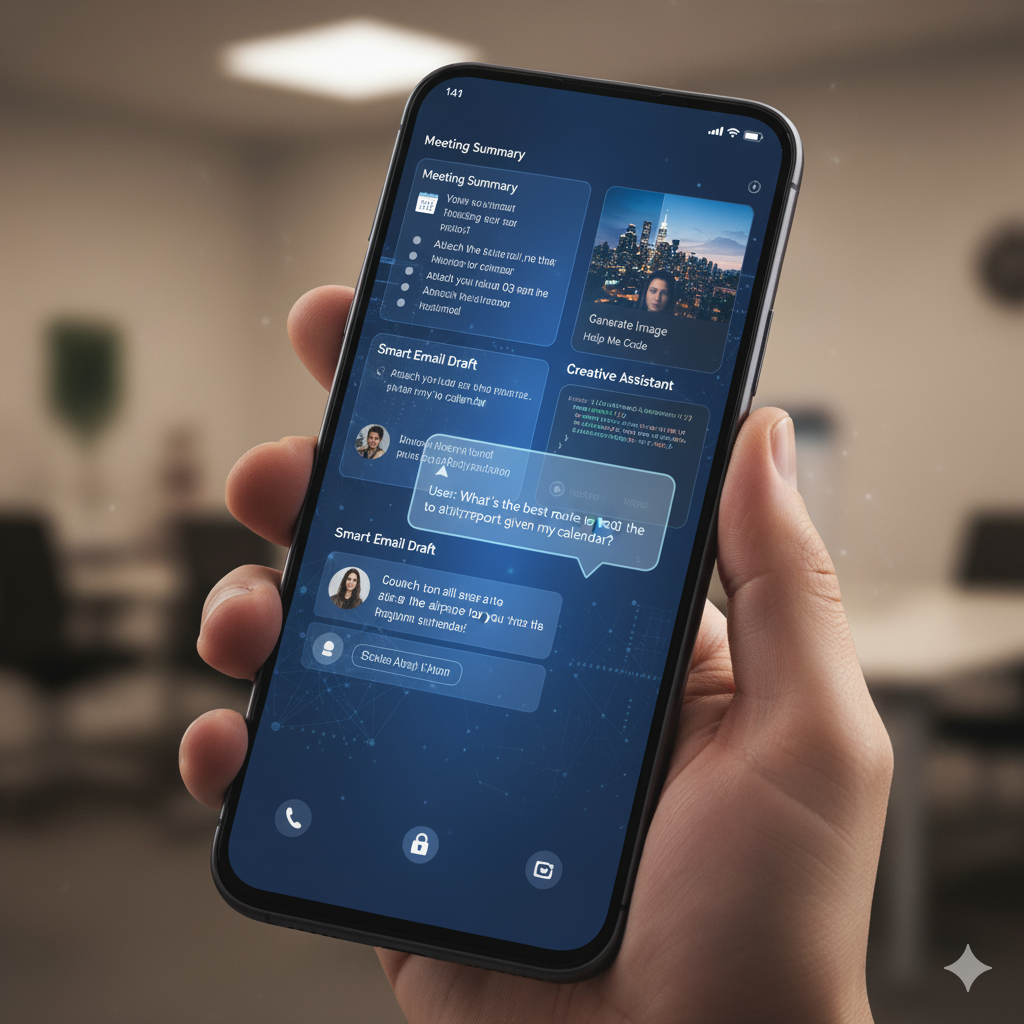
What are the latest AI features on smartphones? The newest generation includes:
- Samsung Galaxy AI with intelligent photo editing, real-time translation, and AI-powered note summaries
- Google Gemini is deeply integrated into Android for contextual assistance across all apps
- Apple Intelligence (rolling out gradually) bringing system-wide AI writing tools and enhanced Siri capabilities
- Circle to Search on Android phones—simply circle, highlight or scribble on anything you see to search without switching apps
Real-World Applications People Actually Use
Generative AI on smartphones enables genuinely useful productivity features:
Meeting and note-taking:
- Automatic transcription and summarization of voice recordings
- Intelligent highlighting of key points and action items
- Quick recap generation for lengthy discussions
Communication enhancement:
- AI writing assistance for emails and messages that match your tone
- Instant translation of conversations, text, and even live camera feeds
- Grammar and style suggestions as you type
Creative tools:
- On-demand image generation and editing with text prompts
- Background removal and object manipulation
- Style transfers and artistic effects
Learning and problem-solving:
- Code completion for developers working on mobile
- Math problem-solving through camera recognition
- Language learning with real-time pronunciation feedback
The Reality Check: User Reception and Adoption
The Enthusiasm Gap Nobody’s Talking About
Here’s the uncomfortable truth manufacturers don’t advertise: despite billions invested in AI smartphone features, most users remain unconvinced of their value.
Recent surveys reveal sobering statistics:
- 73% of iPhone users say AI features add little to no value to their experience
- 87% of Samsung users feel the same way about their phone’s AI capabilities
- Only 47% of Galaxy users have even bothered trying the AI features their phones offer
Why such low adoption? Several factors contribute:
Discovery problems: Many users don’t know these features exist or how to access them. AI tools are often buried in settings menus or require specific gestures to activate.
Value confusion: It’s not always clear what problem a particular AI feature solves or when you’d use it in real life.
Overcomplicated interfaces: Some AI features require multiple steps or specific circumstances to work properly, creating friction that discourages use.
Common Concerns Holding Users Back
Privacy and data security remain paramount worries. Users want to know: Is my data processed on-device or sent to the cloud? What information is stored, and who has access to it? The trend toward on-device AI processing addresses these concerns by keeping sensitive data local rather than transmitting it to remote servers.
Battery life impact is another practical concern. AI features that constantly analyze your behavior or process information require power, potentially reducing the time between charges.
Learning curves feel steep when new AI tools don’t work intuitively. Features that require training or configuration often get abandoned before users experience their benefits.
The gimmick factor can’t be ignored. Some AI features feel like marketing stunts rather than practical tools—impressive in demos but rarely useful in daily life.
Industry Strategies: Why Every Company Wants AI in Your Phone
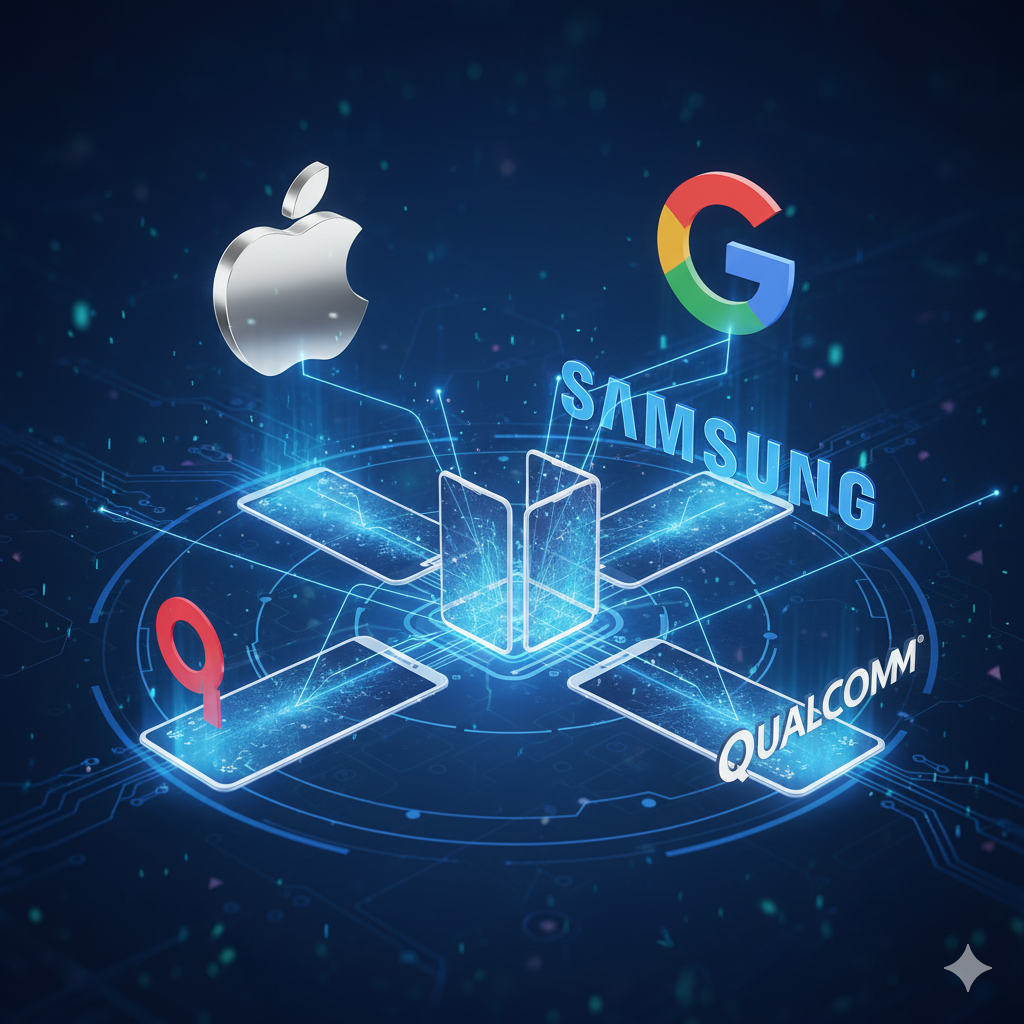
How Major Players Approach AI Differently
Apple’s philosophy: Privacy-first, gradual integration that happens invisibly. Apple Intelligence emphasizes on-device processing and carefully curated features that “just work” without user intervention.
Google’s strategy: Deep, system-wide integration with Gemini serving as the central AI brain for Android. Google leverages its search and cloud AI expertise to offer powerful features that rely on cloud processing when needed.
Samsung’s balancing act: Creating differentiated Galaxy AI features while maintaining compatibility with Google’s Android ecosystem. Samsung focuses on practical tools like translation, summarization, and advanced photo editing.
Qualcomm and chip makers: Driving the hardware foundation with increasingly powerful NPUs that enable more sophisticated on-device AI while consuming less battery.
The Business Case Behind the AI Push
Why are manufacturers so aggressive about adding AI to smartphones? Several compelling business reasons:
Reviving upgrade cycles: In a saturated smartphone market where people keep devices for 3-4 years, AI features provide new reasons to buy the latest models.
Justifying premium pricing: AI capabilities help manufacturers charge more for flagship devices and create clear differentiation from budget options.
Ecosystem lock-in: AI features that learn your preferences and integrate with other devices make switching platforms more painful, increasing customer retention.
Future-proofing: Companies view smartphone AI as preparation for the next computing paradigm, whatever that might be.
What Actually Works: Practical AI Applications
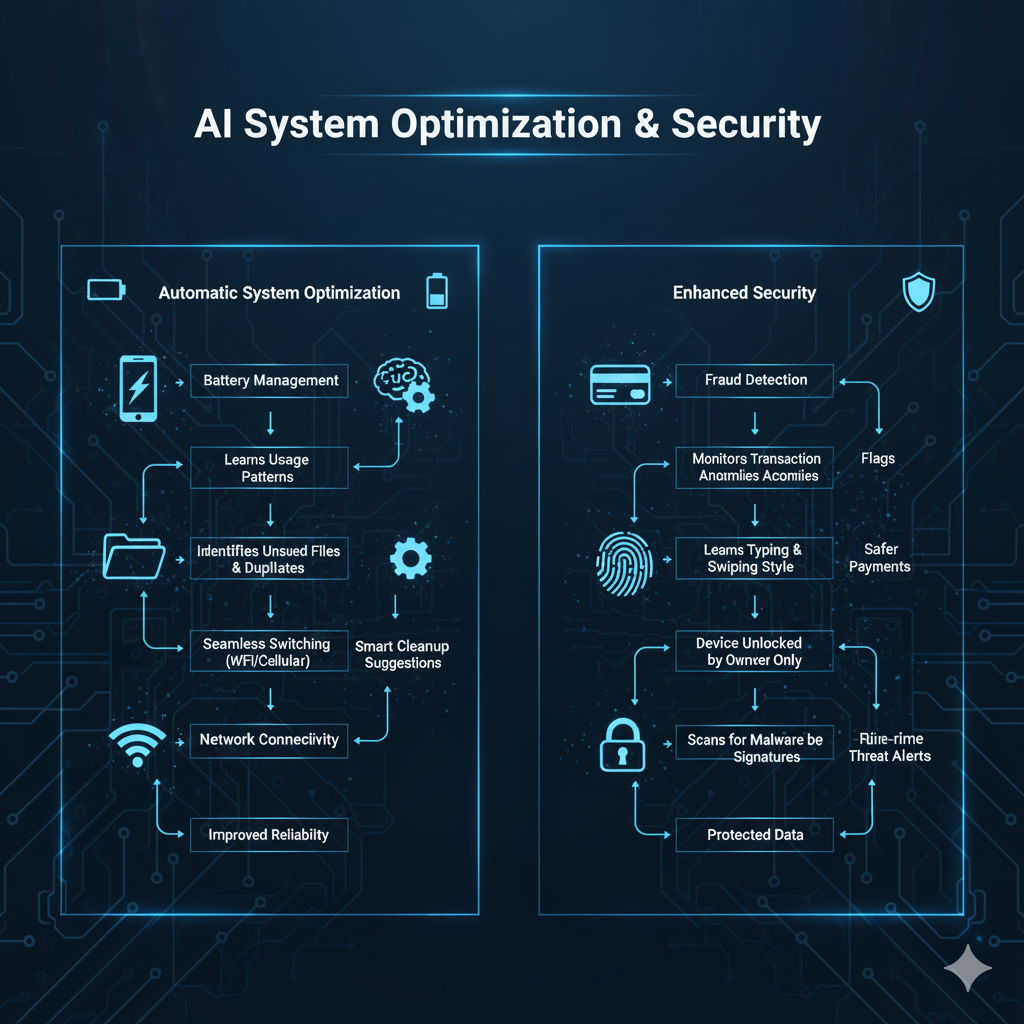
Behind-the-Scenes AI (The Success Stories)
Ironically, the most successful AI features are the ones users barely notice. These invisible improvements enhance the core smartphone experience without requiring any effort:
Automatic system optimization:
- Intelligent battery management that learns which apps you use when and adjusts power allocation accordingly
- App hibernation that frees up storage by temporarily removing unused apps
- Smart network switching between Wi-Fi and cellular for optimal connectivity and data usage
Security enhancements:
- Behavioral biometrics that detect unusual usage patterns indicating unauthorized access
- Real-time fraud detection when entering payment information
- Threat identification that recognizes malicious apps before they cause damage
Performance management:
- Predictive app loading that pre-launches frequently used apps
- Memory optimization based on usage patterns
- Thermal management that prevents overheating during intensive tasks
User-Facing AI (More Mixed Results)
Features users interact with directly show uneven success rates:
What’s working well:
- Camera improvements remain the killer app for smartphone AI—users love taking better photos effortlessly
- Basic voice commands for simple tasks like timers, reminders, and quick searches
- Predictive text that significantly reduces typing time
What’s struggling to find an audience:
- Complex generative AI tools that require specific prompts or understanding of how AI works
- AI writing assistants that feel robotic or don’t match personal voice
- Advanced automation features that take more time to set up than they save
The pattern is clear: AI features that work automatically in the background or improve existing behaviors succeed, while those requiring new learned behaviors struggle.
Challenges and Limitations Still to Overcome
Technical Hurdles
Processing constraints: Even with dedicated NPUs, running sophisticated AI models on smartphone hardware has limits. More complex tasks still require cloud processing, introducing latency and privacy concerns.
Battery drain remains real: Continuously running AI analysis consumes power. Manufacturers must balance capability with battery life—a challenge that hasn’t been fully solved.
Model accuracy varies: AI isn’t perfect. Autocorrect still embarrasses us, voice assistants misunderstand commands, and image recognition makes mistakes. Users need to trust AI decisions, and inconsistency erodes that trust.
Connectivity dependence: Many impressive AI features require internet connections to access cloud-based models, limiting functionality in poor signal areas.
User Experience Obstacles
Feature discoverability remains poor: Most users only discover a fraction of their phone’s AI capabilities. Without clear onboarding or intuitive access, powerful features go unused.
Performance inconsistency frustrates: When AI features work brilliantly sometimes but fail other times, users stop relying on them. Consistency matters more than peak capability.
Overcomplexity for average users: Many AI features are designed by and for tech enthusiasts, not everyday users who want simple solutions to common problems.
Workflow integration challenges: The best tools fit seamlessly into how people already work. AI features that require changing established habits face adoption barriers.
Ethical and Privacy Considerations
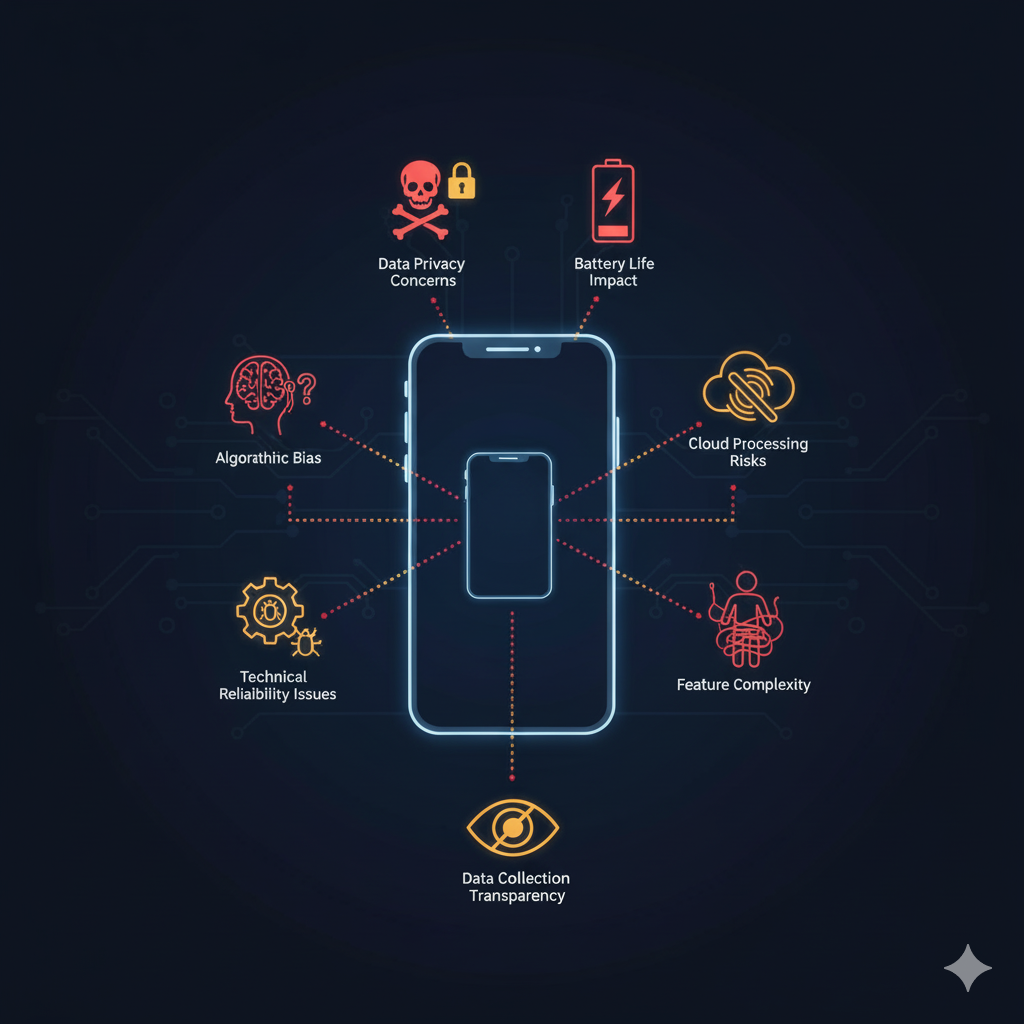
Data transparency matters: Users deserve clear answers about what data AI features collect, how it’s used, and how long it’s retained. Vague privacy policies create justified skepticism.
Algorithmic bias concerns: AI systems trained on biased data can perpetuate or amplify those biases. Facial recognition that works better for some demographics than others, for example, raises fairness questions.
Human skill atrophy risks: As AI handles more cognitive tasks, there’s legitimate concern about people losing skills they once relied on—from basic math to writing clearly.
Dependency dangers: Over-reliance on AI for decision-making, information verification, and problem-solving could reduce critical thinking skills.
The Future of AI Smartphones
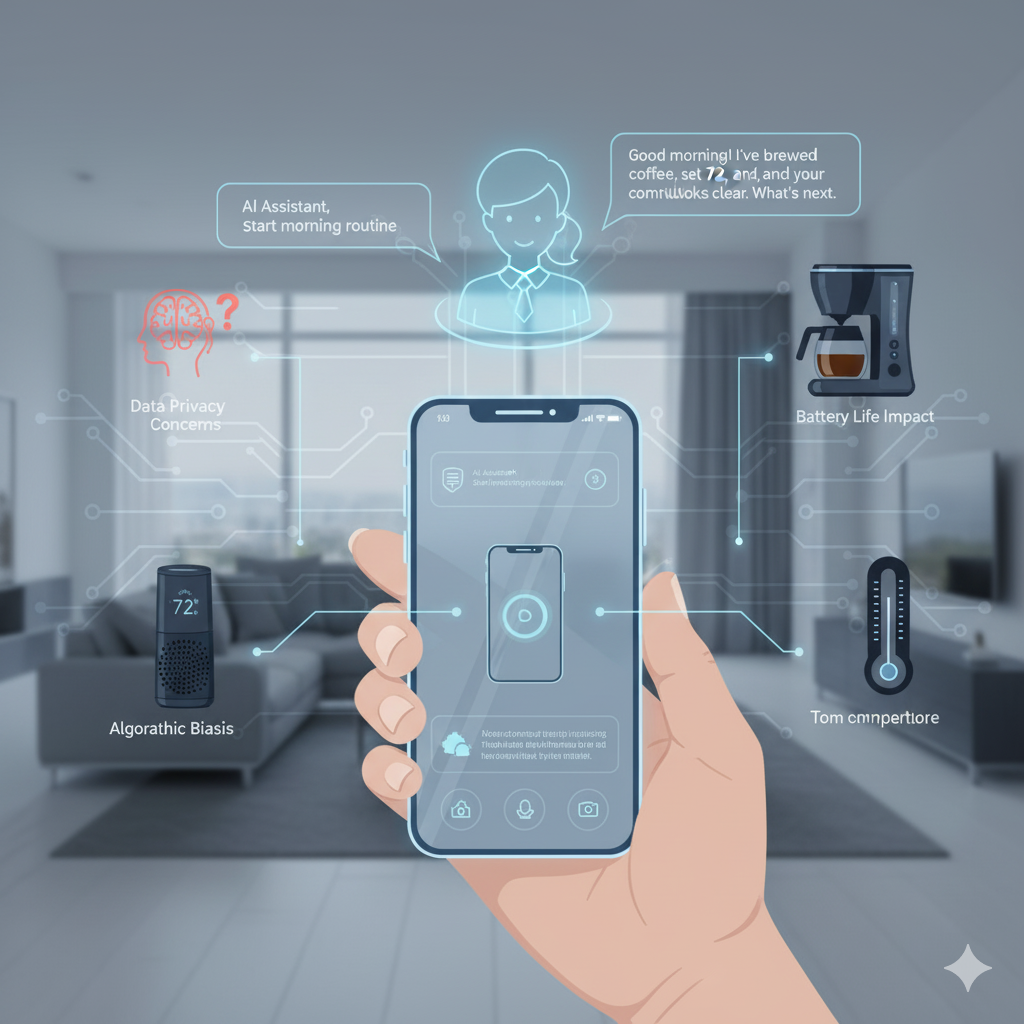
Voice control, IoT integration, and AI assistant interactions
Short-Term Evolution (1-2 Years)
Expect refinement more than revolution in the immediate future:
- Better integration of existing features so they work together seamlessly rather than as disconnected tools
- Improved on-device processing as new NPU generations enable more sophisticated local AI
- More intuitive interfaces that reduce the learning curve for AI features
- Stronger privacy protections with clearer controls and truly local processing for sensitive tasks
- Battery efficiency improvements that make always-on AI feasible
Long-Term Vision (3-5 Years)
The more ambitious transformations will take time:
- True contextual understanding where AI assistants genuinely comprehend complex situations and provide relevant help
- Seamless multimodal interaction combining voice, text, gestures, and visual input naturally
- Proactive AI that anticipates needs before you express them—without feeling creepy
- Deep IoT integration making smartphones the control center for smart homes, cars, and wearables
- Personalized AI models that learn your specific patterns while maintaining privacy
Potential Paradigm Shifts
The truly transformative possibilities could reshape smartphones entirely:
Moving beyond apps: Instead of launching specific applications, you might simply tell your phone what you want to accomplish, and AI figures out which tools to use.
Voice and gesture as primary inputs: Touch screens might become secondary as natural language and physical gestures take over as the main interaction methods.
AI-first operating systems: Rather than AI being a feature layer on top of traditional operating systems, the entire interface could be AI-driven and dynamically generated.
Smartphones as AI hubs: Your phone might become primarily a processing and authentication device that connects to various displays and input methods throughout your environment.
Where We Stand and Where We’re Heading
AI in smartphones is simultaneously overhyped and underappreciated. The technology has genuine transformative potential, but we’re clearly still in the early stages of figuring out how to harness it effectively.
Key takeaways for right now:
The most valuable AI features work quietly in the background—optimizing battery life, securing your device, and perfecting photos automatically. These invisible improvements justify the technology far more than flashy generative AI demos that most people rarely use.
User adoption remains surprisingly low despite aggressive marketing, revealing a gap between what manufacturers think people want and what actually improves daily life. Until AI features become more intuitive, clearly valuable, and trustworthy, many will remain underutilized.
What this means for smartphone users:
Focus on AI features that solve real problems you actually have, not capabilities that sound impressive but don’t fit your routine. Understand the privacy implications of different AI features—particularly whether they process data locally or in the cloud—and make informed choices about what you enable.
Expect gradual improvements rather than sudden breakthroughs. The smartphone AI experience will get steadily better, but transformation happens incrementally through refinement, not overnight through revolution.
The bigger picture:
Smartphones represent the first wave of mainstream AI adoption, but they’re just the beginning. The lessons learned from smartphone AI—what works, what doesn’t, and what users actually value—will shape the next generation of AI-powered devices and services.
Success ultimately depends on making AI genuinely helpful rather than just impressive. Features must become simpler to use, more reliable in performance, and more transparent in operation. When AI fades into the background and simply makes life easier without demanding attention, that’s when it will have truly changed the smartphone experience.
